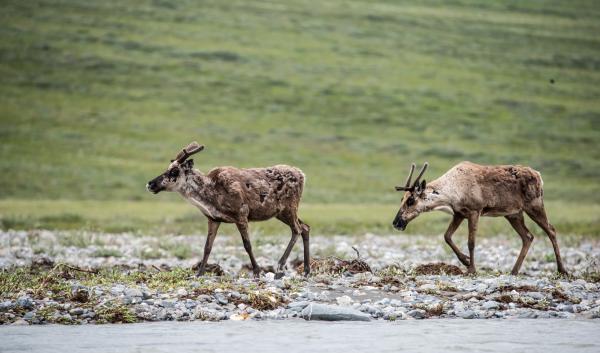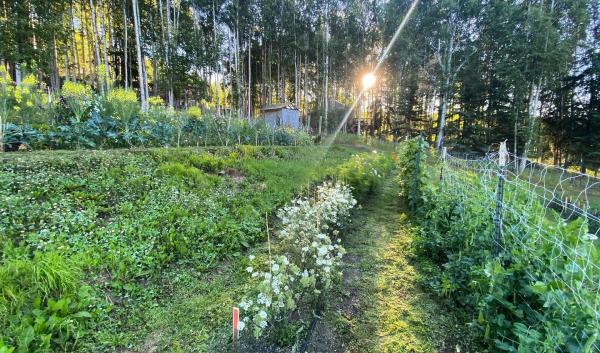Estimated reading time: 7 minutes

Food security means having access to enough nutritious, affordable food to maintain an active and healthy life. In Alaska, the largest and most remote U.S. state, food security is threatened by a number of factors. Because most of the food purchased in the state is imported, and communities must rely on long supply chains to receive food, parts of Alaska have the highest food insecurity rates in the nation. One in nine Alaskans struggles with hunger, a number that rises in rural and Alaska Native communities where supply chains are even longer and can be interrupted by extreme weather, wildfires, or pandemics.
Climate change is likely to increase instances of extreme events that impact food production, distribution, and security. Supply-chain interruptions can have major consequences, particularly for rural communities that rely heavily on imported food. Food insecurity can cause health problems such as malnutrition and obesity, affecting remote communities, including Alaska Natives, more acutely than urban communities.
Climate change may further weaken food security in the state. Imported food currently relies on air transport to reach many communities, and climate-related wildfire smoke and changes to weather patterns can disrupt food supply chains, delaying critical food shipments and spoiling fresh produce. In addition, extreme weather events, which are likely to increase with climate change, can damage crops and make harvesting more difficult. Unlike most other states, food security in Alaska is based on both commercial and wild harvest (also known as subsistence) foods. Climate change is threatening wild harvest practices by shifting the migratory patterns of some animals and complicating harvester access to food sources.
Agriculture
The cold climate and short growing season in Alaska limit the amount of food that can be grown locally. Only a small portion of the food Alaskans purchase and consume is produced in the state. In some cases, the effects of climate change could strengthen food security. The growing season has already lengthened due to rising temperatures, and climate change is likely to continue the trend toward a longer growing season and more frost-free days. In the long-term, acreage for agriculture and agricultural yield are likely to expand due to changes in soil development processes in a warmer climate, permafrost thaw, and a lengthening growing season.
These changes will open up a number of agricultural possibilities. As the climate becomes more favorable to agriculture, Alaskan farmers may be able to expand their production of crops such as soybeans, corn, cucumbers, and tomatoes, alongside more cold-hardy crops. The state’s vulnerability to supply chain breakdowns (which could occur more frequently with climate change) could be decreased by a larger yield of fresh, nutritious food paired with a more localized food system.
In Alaska, 43% of farms are on fewer than 10 acres. Because small farms tend to grow a variety of crops, they can be more resilient to the effects of climate change than larger, monocrop farms. Though climate-informed agricultural practices (e.g., water catchment ponds, greenhouses, high tunnels) can help boost small farm resilience, these practices can be difficult to adopt by small farms that lack the resources of larger farms. Increasing access to funding opportunities for climate-informed practices could boost the resilience of farms throughout the state.
Though climate change could positively affect Alaskan food security, there will likely be some negative effects as well. Drought, extreme precipitation, heat waves, and other extreme events are expected to increase. These events can damage crops and affect wild harvest resources, which could impact food security. In addition, increased pressure from insects and invasive species could affect agricultural yield, counteracting some or all boosts in yield.
Mariculture
Mariculture, or the cultivation of marine life for food, is an expanding industry in Alaska. Shellfish (e.g., oysters, clams) and seaweed farming are increasingly popular, particularly in Southeast and South-Central Alaska. These industries have the potential to increase food security in the state, though they are also vulnerable to climate change.
Seaweed farming can contribute to food security because seaweed grows quickly and, in some cases, has a high protein content. At a local level, seaweed can also capture carbon dioxide from the marine environment and reduce ocean acidification and de-oxygenation, which threaten marine environments. As a result, when coupled with shellfish farming units, seaweed farming could protect shellfish from some of the effects of ocean acidification. There has been an increase in the number of applications for seaweed farming permits in the state.
Shellfish farming could be negatively affected by climate change. Shellfish are particularly vulnerable to ocean acidification, which is exacerbated by rising greenhouse gas emissions associated with climate change. In addition, rising ocean temperatures make shellfish more vulnerable to diseases and pathogens that can cause shellfish poisoning. Though shellfish and seaweed farming face challenges, the expansion of these industries could help to boost food security by strengthening the local food economy, particularly if farmers implement climate adaptation practices that build climate resilience.
Wild foods play an important role in Alaskan food security and, like agriculture and mariculture, will experience varied effects from climate change. Climate change has led to shifts in the location and timing of some animal migration patterns, which can complicate the harvest of wild foods. Coastal storms, early ice breakup, and other extreme events associated with climate change can lead to unpredictable travel conditions that can endanger wild harvesters and reduce access to critical food sources. Food storage facilities that rely on natural ice, such as permafrost cellars, can thaw in rising temperatures and affect the storage of wild foods, affecting food security in rural communities. Because Alaska Natives rely on wild food harvest for cultural values, spirituality, and food security, their communities are disproportionately affected by climate change. Climate change is severely impacting Alaskan fisheries. In the 5-year period from 2018 to 2023, 17 formal and pending fishery disaster declarations were issued, compared to seven disaster declarations in the 32-year period from 1985 to 2017. In recent years, several fisheries throughout the state have closed or limited production due to decreases in fish. The Yukon subsistence salmon fishing season has also experienced restrictions and closures in recent years, with major impacts to Alaska Native communities and ways of life. In addition to affecting communities that rely on wild harvest fishing, these declines have serious implications for commercial and recreational fisheries. Alaskans are already making efforts to improve food security. Many Alaskan farmers grow food in high tunnels or hoop houses to protect crops from extreme weather, and others use cover crops to retain and improve soil health. Some small farms offer food products directly to nearby consumers through Community Supported Agriculture (CSA) or farmers markets. Producers like Calypso Farm and Ecology Center are offering agricultural trainings to aspiring farmers and youth to build agricultural climate resilience. Alaska Natives are at the cutting edge of efforts to improve food security in the state. For example, the Native Village of Tyonek and the Tyonek Tribal Conservation District started a program to improve food security through community agriculture. The Tyonek community garden is a 1.5-acre operation with two high tunnels, solar-powered irrigation and ventilation systems, 15 outdoor raised beds, and 2,000 row-feet of potatoes, mixed vegetable crops, and perennial fruits. This garden provides food for community members in a remote area off the road system across the Cook Inlet from Anchorage. Efforts like the Tyonek community garden could be replicated to boost food security and sovereignty in other remote regions of Alaska. Efforts to restore habitat and maintain access to wild harvest resources have also been led by Alaska Natives. The Alaska Native Regional Corporation, Koniag, and the Natural Resource Conservation Service worked to restore access to traditional hunting and fishing grounds in remote Larsen Bay on Kodiak Island. In another example, the Village of Tyonek implemented a project to replace stream culverts that were impassable to salmon. So far, they have restored 46 miles of stream habitat. Efforts to improve food security still have a long way to go, but opportunities are plentiful. The USDA and Alaska Food Policy Council developedWild Harvest Resources
Efforts to Improve Food Security

- Improve food system literacy and skills to build greater capacity, awareness, and interest in food security through efforts like youth and elder food education and mentorship.
- Build and improve food system physical infrastructure through efforts like community commercial kitchens, food storage space, and growing season extension.
- Promote food justice, food sovereignty, greater access, and cultural awareness of foodways and traditions through efforts like tribal outreach for Alaska Natives and food waste recapture.
- Provide technical expertise and grant opportunities to increase food system capacity through efforts like mariculture, kelp harvesting as livestock feed, and grant writing workshops.
- Improve and create markets and food production by increasing the viability of local agriculture, building relationships within the industry, and addressing food waste.
Many people and organizations are dedicating resources and time to boost food security throughout the state. As the climate continues to change, climate adaptation and mitigation will be important considerations in continuing the path towards greater food security. For example, Alaskans can promote sustainable agriculture practices, such as no-till farming and cover cropping, minimize the use of pesticides, and raise livestock alongside crops, which can help to improve soil health. Consumers can also support local food production, which can help to reduce food transportation emissions. Businesses and government entities can invest in energy-efficient food processing and distribution facilities. By working together, Alaska can build a more resilient food system that can withstand the challenges of the future.
Alaska's Changing Environment is a report from Alaska Center for Climate Assessment and Policy that highlights environmental changes and extremes that impact Alaskans lives and livelihoods.
Alaska Food Policy Council Food Security Action Plan includes recommendations for improving food security throughout the state and was funding by the USDA Regional Food System Planning Grant.
Alaska Food Security and Independence Task Force 2023 Report is a tool for building policies and programs to strengthen and grow the state’s food system for all Alaskans. It includes background context and sections that address food security directives.
Alaska and a Changing Climate is a Northwest Climate Hub webpage about climate change impacts occurring and expected to occur in Alaska.
Adaptation Resources for Agriculture: Responding to Changing in Climate in Alaska is a Hub workbook that provides information, resources, and case studies to help agricultural producers in Alaska adapt to a changing climate.
Seaweed Farming in Alaska is a Northwest Climate Hub webpage the explore the climate adaptation and mitigation potential of seaweed farming.
University of Alaska-Fairbanks Cooperative Extension provides information on a variety of topics related to food security for Alaskan producers.
- UAF Alaska Tribes Extension Program promotes food sovereign and secure Tribes in Alaska and offers hands-on and virtual workshops throughout the state in partnership with Tribes and Traditional Ecological Knowledge Holders.
-
Climate Change and Wild Foods in Alaska
Climate change is altering the abundance and location of a variety of wild foods in Alaska, affecting food security.
-
Food Security and Justice at Calypso Farm, Alaska
This Adaptation in Action profile highlights Calypso Farm’s efforts to increase community access to local food and agricultural education.




